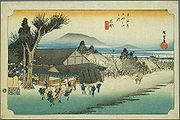
Ishibe-juku
Encyclopedia

53 Stations of the Tokaido
The are the rest areas along the Tōkaidō, which was a coastal route that ran from Nihonbashi in Edo to Sanjō Ōhashi in Kyoto.-Stations of the Tōkaidō:...
of the Tōkaidō
Tokaido (road)
The ' was the most important of the Five Routes of the Edo period, connecting Edo to Kyoto in Japan. Unlike the inland and less heavily travelled Nakasendō, the Tōkaidō travelled along the sea coast of eastern Honshū, hence the route's name....
. It is located in the downtown area of the present-day city of Konan
Konan, Shiga
is a city located in the southern part of Shiga, Japan. The city was founded on October 1, 2004 by the merger of the towns of Kōsei and Ishibe, both from Kōka District. The total area is 70.49 km²....
, Shiga Prefecture
Shiga Prefecture
is a prefecture of Japan, which forms part of the Kansai region on Honshu Island. The capital is the city of Ōtsu.- History :Shiga was known as Ōmi Province or Gōshū before the prefectural system was established...
, Japan
Japan
Japan is an island nation in East Asia. Located in the Pacific Ocean, it lies to the east of the Sea of Japan, China, North Korea, South Korea and Russia, stretching from the Sea of Okhotsk in the north to the East China Sea and Taiwan in the south...
. Because it only took approximately one day to travel from Kyoto
Kyoto
is a city in the central part of the island of Honshū, Japan. It has a population close to 1.5 million. Formerly the imperial capital of Japan, it is now the capital of Kyoto Prefecture, as well as a major part of the Osaka-Kobe-Kyoto metropolitan area.-History:...
to Ishibe-juku, there was a saying that went, "rise in Kyoto, stay in Ishibe."
History
Ishibe-juku was originally formed in 1571, when Oda NobunagaOda Nobunaga
was the initiator of the unification of Japan under the shogunate in the late 16th century, which ruled Japan until the Meiji Restoration in 1868. He was also a major daimyo during the Sengoku period of Japanese history. His opus was continued, completed and finalized by his successors Toyotomi...
formed the town of Ishibe (石部町 Ishibe-machi) by joining the five nearby villages. In 1597, Toyotomi Hideyoshi
Toyotomi Hideyoshi
was a daimyo warrior, general and politician of the Sengoku period. He unified the political factions of Japan. He succeeded his former liege lord, Oda Nobunaga, and brought an end to the Sengoku period. The period of his rule is often called the Momoyama period, named after Hideyoshi's castle...
further developed the post station to be used for the shipment of goods by travelers on their way to Zenkō-ji
Zenko-ji
' is a Buddhist temple located in Nagano, Japan. The temple was built in the 7th century. Nagano City, established in 1897, was originally a town built around the temple. Historically, Zenkō-ji is perhaps most famous for its involvement in the battles between Uesugi Kenshin and Takeda Shingen in...
in Shinano Province
Shinano Province
or is an old province of Japan that is now present day Nagano Prefecture.Shinano bordered on Echigo, Etchū, Hida, Kai, Kōzuke, Mikawa, Mino, Musashi, Suruga, and Tōtōmi Provinces...
. When the Tōkaidō was established in 1601, Ishibe-juku became an official post station.
Inside the post station, there were two honjin
Honjin
thumb|250px|The honjin at [[Inaba Kaidō]]'s [[Ōhara-shuku]]. is the Japanese word for an inn for government officials, generally located in post stations during the later part of the Edo period.-Evolution of Honjin:...
and 32 other inns among the 458 structures that stretched approximately 1.6km, as was recorded in 1863. In 1864, Tokugawa Iemochi
Tokugawa Iemochi
was the 14th shogun of the Tokugawa shogunate of Japan, who held office 1858 to 1866. During his reign there was much internal turmoil as a result of Japan's first major contact with the United States, which occurred under Commodore Perry in 1853 and 1854, and of the subsequent "re-opening" of...
, the fourteenth shogun
Shogun
A was one of the hereditary military dictators of Japan from 1192 to 1867. In this period, the shoguns, or their shikken regents , were the de facto rulers of Japan though they were nominally appointed by the emperor...
of Japan, stayed at one of the two honjin, those his visit was preceded in 1863, by Tokugawa Yoshinobu
Tokugawa Yoshinobu
was the 15th and last shogun of the Tokugawa shogunate of Japan. He was part of a movement which aimed to reform the aging shogunate, but was ultimately unsuccessful...
, who would eventually become the fifteenth shogun of Japan. There is not much remaining of the original buildings today, but there is an archives museum dedicated to the former post town in Konan.

